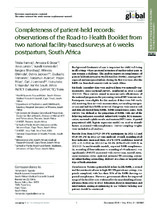Completeness of patient-held records: observations of the Road-to-Health Booklet from two national facility-based surveys at 6 weeks postpartum, South Africa
Date
2018Author
Ramraj, Trisha
Goga, Ameena E.
Larsen, Anna
Ramokolo, Vundli
Bhardwaj, Sanjana
Chirinda, Witness
Jackson, Debra
Nsibande, Duduzile
Ayalew, Kassahun
Pillay, Yogan
Lombard, Carl J.
Ngandu, Nobubelo K.
Metadata
Show full item recordAbstract
BACKGROUND Continuity of care is important for child well-being
in all settings where postnatal retention of mother-infant pairs in
care remains a challenge. This analysis reports on completeness of
patient-held infant Road to Health Booklets (RtHBs), amongst HIV
exposed and unexposed infants during the first two years after the
RtHB was launched country-wide in South Africa.
METHODS Secondary data were analysed from two nationally representative,
cross-sectional surveys, conducted in 2011-12 and
2012-13. These surveys aimed to measure early effectiveness of
the national programme for preventing vertical HIV transmission.
Participants were eligible for this analysis if they were 4-8 weeks
old, receiving their six-week immunisation, not needing emergency
care and had their RtHBs reviewed. Caregivers were interviewed
and data abstracted from RtHBs. RtHB completeness across both
surveys was defined as the proportion of RtHBs with any of the
following indicators recorded: infant birth weight, BCG immunisation,
maternal syphilis results and maternal HIV status. A partial
proportional odds logistic regression model was used to identify
factors associated with completeness. Survey sampling weights
were included in all analyses.
RESULTS Data from 10 415 (99.6%) participants in 2011-12 and
9529 (99.2%) in 2012-13 were analysed. Overall, recording of all
four indicators increased from 23.1% (95% confidence interval
(CI) = 22.2-24.0) in 2011-12 to 43.3% (95% CI = 42.3-44.4) in
2012-13. In multivariable models, expected RtHB completeness
(ie, recording all four indicators vs recording of <4 indicators), was
significantly (P<0.05) associated with survey year, marital status,
socio-economic status, maternal antenatal TB screening, antenatal
infant feeding counselling, delivery at a clinic or hospital and
type of birth attendant.
CONCLUSIONS Routine patient-held infant health RtHB, a critical
tool for continuity of care in high HIV/TB prevalence settings, was
poorly completed, with less than 50% of the RtHB showing expected
completeness. However, government efforts for improved
usage of the booklet were evidenced by the near doubling of completeness
from 2011 to 2013. Education about its importance and
interventions aiming at optimising its use without violating user
privacy should be continued.

